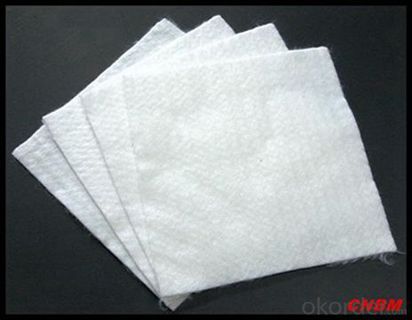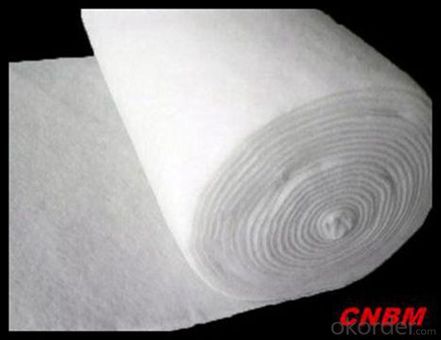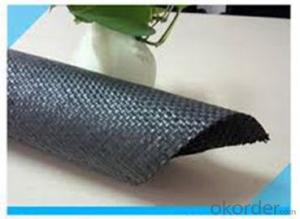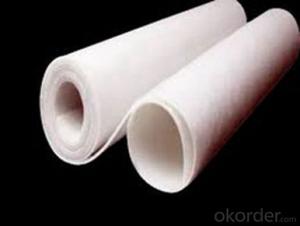PP Nonwoven Geotextile Fabric Reinforcement and Drainage CNBM
- Loading Port:
- China main port
- Payment Terms:
- TT OR LC
- Min Order Qty:
- 4000 g/m²
- Supply Capability:
- 1000000 g/m²/month
OKorder Service Pledge
OKorder Financial Service
You Might Also Like
Item specifice



Product Description
1. short fiber needle punched nonwoven geotextiles (heat set or not) Pet short fiber
Geotextiles are permeable nonwoven fabrics used to separate,filter,reinforce, protect or drain.Geotextiles allow filtration or separation of granular layers in roads and rail applications,used to protect membranes in landfill applications,used in coastal defence applications and used in landscaping to protect surfaces and structures from weeds and root growth.
Geotextiles are availabel as woven and non-woven .As liner protection, against physical damage, the non wovens are normally the answer.They are made up of fibers of polyester or polypropylene in random directions and punched together by needles during the manufacturing process.Geotextiles are commenly used to separate layers like clay and drainage and to protect liner from damage.
FAQ:
Q: What kind of payments does jenor support?
A: T/T, L/C, Cash are accepted.
Q: Do you charge for the samples?
A: Accordeing to our company policy, the samples are free, we only charge the freight fee. And we will return the freight fee during the next order.
Q: Can you produce according to customers' design?
A: Sure, we are professional manufacturer, OEM and ODM are both welcome.
Q: Do you have other products?
A: Yes, please check the pictures:
Packaging & Shipping
Packing: PLASTIC FILM INSIDE, AND WOVEN BAG OUTSIDE
Shipping: About 15 days after receipt the deposit
Quality assurance
1.On a regular basis or as per your request,we entrust national testing agencies to conduct quality inspections
2. Strictly in accordance with the ISO9001-2008 international quality system standard,we monitor and manage the whole process throughout production,quality testing,and measurement to ensure product quality
3. For quality-related construction delay or substandard construction(except for damage or losses due to customer’s responsibility or irresistible natural disasters),we have refunding,replacement,and repair services.We will respond to customers’ feedbacks on quality issues within 24 hours.
- Q:What is geotextile? Its use
- Geotextile is a kind of non-woven fabric. Its use is the road moisturizing, dam protection, reinforcement, isolation.
- Q:What are the installation techniques for geotextiles?
- There are several installation techniques for geotextiles, depending on the specific application and site conditions. Some common techniques include anchoring the geotextile with stakes or pins, securing it with sandbags or gravel, or using mechanical devices such as anchors or screws. The geotextile may also be overlapped and sewn together, or heat-welded to create a continuous barrier. It is important to follow the manufacturer's guidelines and industry standards when installing geotextiles to ensure proper functionality and longevity.
- Q:What are the considerations for geotextile selection in riverbank stabilization?
- When selecting geotextiles for riverbank stabilization, several considerations should be taken into account. Firstly, the strength and durability of the geotextile are crucial factors. It should have sufficient tensile strength and resistance to degradation from UV radiation, chemicals, and biological agents. Additionally, the permeability of the geotextile plays a vital role in allowing water to pass through while preventing soil erosion. The geotextile should also be compatible with the soil type and vegetation in the area to ensure proper integration and long-term stability. Finally, the cost-effectiveness and ease of installation should be considered to ensure practicality and efficiency in the riverbank stabilization process.
- Q:How do geotextiles contribute to environmental sustainability?
- Geotextiles contribute to environmental sustainability in various ways. Firstly, they help in erosion control by stabilizing soil and preventing soil erosion, which in turn protects the natural environment and prevents sedimentation in water bodies. Secondly, geotextiles can be used for soil reinforcement and slope stabilization, reducing the need for excessive excavation and land disturbance. Additionally, geotextiles can be employed in waste management systems, such as landfill liners and covers, minimizing the risk of contamination to soil and groundwater. Overall, geotextiles offer eco-friendly solutions for various construction and environmental projects, promoting long-term sustainability.
- Q:Are geotextiles suitable for use in railway ballast stabilization?
- Yes, geotextiles are suitable for use in railway ballast stabilization. Geotextiles can improve the stability and performance of railway ballast by preventing the mixing of ballast and subgrade soils, reducing track settlement, improving drainage, and enhancing overall load-bearing capacity. They also help in reducing maintenance needs and increasing the lifespan of the railway tracks.
- Q:Can geotextiles be used in the construction of artificial islands?
- Yes, geotextiles can be used in the construction of artificial islands. Geotextiles are permeable fabrics that can provide effective soil stabilization, erosion control, and filtration. They can be used as a protective layer between the island's foundation and the surrounding water, preventing erosion and promoting stability. Additionally, geotextiles can assist in the drainage system of the island, allowing excess water to flow through while retaining the soil. Thus, geotextiles are a valuable tool in the construction and maintenance of artificial islands.
- Q:What is the consequence of the geotextile of the ground floor
- What are the consequences of what can not be finalized, the first roof of the waterproof layer and waterproof protective layer is very important, this is the first barrier, imagine, now many of the green plants are large trees, grow 10 years or even 20 years After the roots will be very developed, think about how the pine trees on the tenacious know their strength, coupled with long-term erosion by the water, the concrete layer will gradually lose its ideal performance, barrier layer and drainage board will certainly be better To protect the role and drainage. So to speak, long-term vision of the words must be solidly do every layer, only focus on economic interests and short-term effects, then, within a few years will not be any problem.
- Q:We have built a swingset with a built in sandbox. I am looking for geotextile fabric to put under the sandbox to keep weeds & roots out. Any ideas where I can get this from? Local home improvement stores do not stock geotextile fabric. I bought some from a pool supply store for my pool bottom, but they don't sell custom sizes.
- I'm really surprised. All of the Lowe's, Home Depots, etc. that I know of stock landscape barrier fabric, as do all the garden supply shops. If you truly can't find any, carpet works well, as will corrugated cardboard for a season. If the kids use the sandbox a lot, they'll usually keep the weeds down, too.
- Q:Can geotextiles be used in waste storage facility applications?
- Yes, geotextiles can be used in waste storage facility applications. Geotextiles are commonly used in these facilities to provide erosion control, filtration, and separation of different waste materials. They help to enhance the stability and performance of the storage facility by preventing soil erosion and promoting proper drainage. Additionally, geotextiles can also be used to cover and contain waste materials, preventing any potential contamination or leaching into the surrounding environment.
- Q:What is the difference between finished and semi-finished products?
- Think of ways to develop customers in the country Well. Foreigners may now also like, in the future may also like to like something else. We have the domestic people's own preferences are unable to control, but also control the other countries ah?
1. Manufacturer Overview |
|
|---|---|
| Location | |
| Year Established | |
| Annual Output Value | |
| Main Markets | |
| Company Certifications | |
2. Manufacturer Certificates |
|
|---|---|
| a) Certification Name | |
| Range | |
| Reference | |
| Validity Period | |
3. Manufacturer Capability |
|
|---|---|
| a)Trade Capacity | |
| Nearest Port | |
| Export Percentage | |
| No.of Employees in Trade Department | |
| Language Spoken: | |
| b)Factory Information | |
| Factory Size: | |
| No. of Production Lines | |
| Contract Manufacturing | |
| Product Price Range | |
Send your message to us
PP Nonwoven Geotextile Fabric Reinforcement and Drainage CNBM
- Loading Port:
- China main port
- Payment Terms:
- TT OR LC
- Min Order Qty:
- 4000 g/m²
- Supply Capability:
- 1000000 g/m²/month
OKorder Service Pledge
OKorder Financial Service
Similar products
New products
Hot products
Related keywords
































